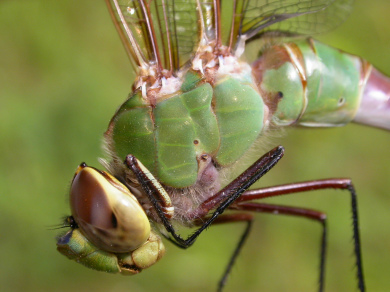In North America, dragonfly migrations occur annually in late summer and early fall, when millions of insects move from Canada and the northern United States down to the Gulf Coast, Mexico, the West Indies, and beyond. North America may have as many as 18 migratory dragonfly species; some engage in annual seasonal migrations, while others are more sporadic migrants.
Spring movements northward by dragonflies are rarely observed, presumably because they occur over a wider front, a longer time period, and involve fewer individuals than in fall. We know these flights take place because adults appear during early spring in areas where nymphs have not yet emerged.
North America’s best-known migrant dragonfly is the Common Green Darner. This species appears at northern latitudes in early spring, often before any local dragonflies have emerged. These early returnees are migrants from the south, having flown from perhaps Florida, the Caribbean, Mexico or beyond.
They breed soon after arriving, and their nymphs develop quickly in wetlands warmed by the summer sun. Many adults emerge in August; instead of maturing and breeding at their natal site, they begin a southward movement that may span a month or longer. Their destinations are currently unknown, but presumed to be the same areas where spring migrants originate. Migrating individuals may breed at their final destination or at sites along the way.
Although migration is a common phenomenon in Common Green Darners, it is not obligatory. Populations in more northern areas are known to consist of both resident and migratory individuals. These phenotypes overlap in space, but exhibit strikingly different annual phenologies that appear to limit temporal overlap in breeding. Migrants arrive at breeding ponds in March–April, and larvae emerge as adults after 4–5 months. Resident darners begin their breeding cycle a month or two later in June–July, and their larvae overwinter in natal ponds, finally emerging as adults in May–June of the following year.
There is evidence that water temperature plays a role in maintaining this phenotypic variation. Final-instar larvae of migratory phenotypes reared in the laboratory required a minimum water temperature of 8.7 C to develop into adults. In Ontario, resident phenotypes required 20% more accumulated warm weather days than migrants to complete larval development. These thresholds suggest that the relative size of migratory populations could vary with latitudinal gradients and associated temperatures.
Despite spanning several countries and having been documented since at least the 1880s, North American dragonfly migration is a poorly understood phenomenon. Knowledge about migratory cues, flight pathways, population connectivity, and the southern limits of overwintering grounds remains fragmentary. This knowledge gap prevents development of international management plans and coordinated conservation actions to sustain and protect the migration. None of the dragonfly species known to undertake migrations in North America are currently endangered, but identifying the habitats on which migrating dragonflies rely for their transcontinental flights may help us better conserve these important systems. Threats to wetland habitats, including the effects of global climate disruption, could alter environmental cues for migration, affect larval development and adult emergence times, disrupt migratory corridors, or render overwintering habitat unsuitable.
The overarching goal of this study is to understand the geographic scale and connectivity of dragonfly migration. Remarkably, we can do this by examining the chemistry locked in dragonfly wings. Stable hydrogen isotopes are ideal to infer natal origins of dragonflies because they reflect the latitude at which body tissues were grown and are chemically inert once bound. Vaporizing a segment of wing in a mass spectrometer provides the chemical “signature” we need to determine latitude of the natal pond where a given dragonfly emerged. With the help of field volunteers and existing museum collections, we are sampling Common Green Darners from Mexico to Texas, across to Florida, and up the eastern half of North America into Canada. We hope our findings will shed important light on one of North America’s most impressive animal migrations.
Learn more about the amazing migration of dragonflies:
May, M. L. (2013). A critical overview of progress in studies of migration of dragonflies (Odonata: Anisoptera), with emphasis on North America. Journal of Insect Conservation, 17(1), 1-15.

